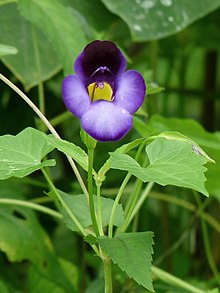
The Bernice Pauahi Bishop Museum, designated the Hawaiʻi State Museum of Natural and Cultural History, is a museum of history and science in the historic Kalihi district of Honolulu on the Hawaiian island of O'ahu. Founded in 1889, it is the largest museum in Hawai'i and has the world's largest collection of Polynesian cultural artifacts and natural history specimens. Besides the comprehensive exhibits of Hawaiiana, the museum's total holding of natural history specimens exceeds 24 million, of which the entomological collection alone represents more than 13.5 million specimens.

Frank Alexander Wetmore was an American ornithologist and avian paleontologist. He was the sixth Secretary of the Smithsonian Institution.
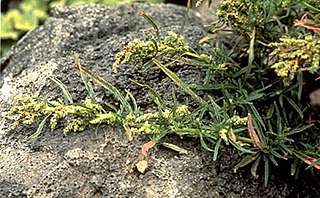
Amaranthus brownii was an annual herb in the family Amaranthaceae. The plant was found only on the small island of Nihoa in the Northwestern Hawaiian Islands, growing on rocky outcrops at altitudes of 120–215 m (394–705 ft). It was one of nine species of Amaranthus in the Hawaiian Islands, as well as the only endemic Hawaiian species of the genus. It is now considered extinct.

Sida fallax, known as yellow ilima or golden mallow, is a species of herbaceous flowering plant in the Hibiscus family, Malvaceae, indigenous to the Hawaiian Archipelago and other Pacific Islands. Plants may be erect or prostrate and are found in drier areas in sandy soils, often near the ocean. ʻIlima is the symbol of Laloimehani and is the flower for the islands of Oʻahu, Hawaiʻi, and Abemama, Kiribati.
Storrs Lovejoy Olson was an American biologist and ornithologist who spent his career at the Smithsonian Institution, retiring in 2008. One of the world's foremost avian paleontologists, he was best known for his studies of fossil and subfossil birds on islands such as Ascension, St. Helena and Hawaii. His early higher education took place at Florida State University in 1966, where he obtained a B.A. in Biology, and the University of Florida, where he received an M.S. in Biology. Olson's doctoral studies took place at Johns Hopkins University, in what was then the School of Hygiene and Public Health. He was married to fellow paleornithologist Helen F. James.

Linderniaceae is a family of flowering plants in the order Lamiales, which consists of about 25 genera and 265 species occurring worldwide. Vandellia micrantha is eaten in Laos, but tastes bitter. Best known are the wishbone flowers Torenia fournieri and Torenia thouarsii, which are used as bedding plants especially in the tropics. Micranthemum is sold as an aquarium plant when it is called 'baby tears'.
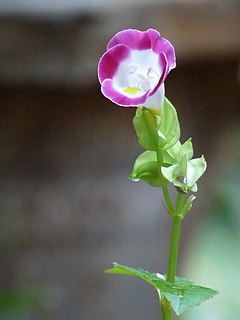
Torenia fournieri, the bluewings or wishbone flower, is an annual plant in the Linderniaceae, with blue, white, or pink flowers that have yellow markings. It is typically grown as a landscape annual, reaching 12–15 in. tall. It has simple opposite or subopposite leaves with serrated edges.
Francis Raymond "Ray" Fosberg was an American botanist. A prolific collector and author, he played a significant role in the development of coral reef and island studies.
The Hawaii Biological Survey, located on the campus of the Bishop Museum in Honolulu, Hawaii, was created as a program of the Bishop Museum by the Hawaii State legislature in 1992. HBS is an ongoing natural history inventory of the Hawaiian archipelago. It was created to locate, identify, and evaluate all native and non-native fauna and flora within the state, and to maintain the reference collections of that biota for a wide range of uses. The Bishop Museum collections are one of the largest in the United States, with more than 23 million specimens and objects.The HBS collections of plants and animals from the Hawaiian Islands total more than 4 million specimens.

Nestegis sandwicensis, commonly known as Hawai'i olive or olopua, is a species of flowering tree in the olive family, Oleaceae, that is endemic to Hawaii. It is found on all major islands at elevations of 30–1,300 m (98–4,265 ft) in coastal mesic and mixed mesic forests, and, especially, dry forests. It usually reaches a height of 6 m (20 ft) with a trunk diameter of 0.2 m (0.66 ft), but may reach 20 m (66 ft) in height with a trunk diameter of 0.9 m (3.0 ft).
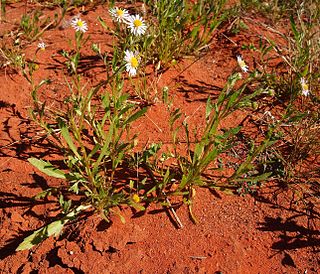
Vittadinia is a genus of Australian and New Zealand plants in the aster tribe within the daisy family.
Chedra microstigma is a tiny moth of the family Batrachedridae described in 1907. It has only been found on Oahu. It has been found feeding on sedges, plants belonging to the Cyperaceae family, and its larvae host at least three species of parasitoids in Hawaii.

Bidens micrantha is a species of flowering plant in the aster family known by the common name grassland beggarticks. It is endemic to the Hawaiian Islands, where it and other Bidens species are known as kōʻokoʻolau. It occurs in many types of habitat on Lānaʻi, Maui, and Hawaiʻi, including rocky cliffs, dry forests, mesic forests, wet forests, and high shrublands.
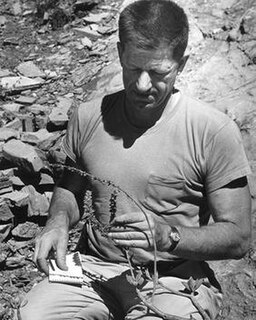
Reid Venable Moran was an American botanist and the curator of botany at the San Diego Natural History Museum from 1957 to 1982.

Plummers Island is a 12-acre Potomac River island in Montgomery County, Maryland, about nine miles upriver from Washington, D.C. The Washington Biologists' Field Club has called the island "the most thoroughly studied island in North America".. The island is visible from the American Legion Memorial Bridge of the Capital Beltway, just downriver (east) of the bridge.
Richard Sumner Cowan was an American botanist.

Vicki Ann Funk was a Senior Research Botanist and Curator at the Smithsonian's National Museum of Natural History, known for her work on members of the composite family (Asteraceae) including collecting plants in many parts of the world, as well as her synthetic work on phylogenetics and biogeography.
Alice R. Tangerini is an American botanical illustrator. In 1972, Tangerini was hired as a staff illustrator for the Department of Botany at the National Museum of Natural History by American botanist Lyman Bradford Smith. Prior to working at the Smithsonian Institution, she received a Bachelor of Fine Arts from Virginia Commonwealth University. As of March 9, 2017, Tangerini remains the only botanical illustrator ever hired by the Smithsonian.
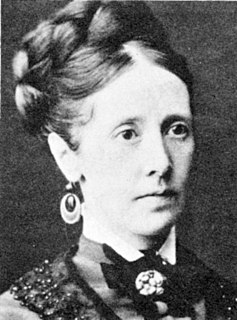
Isabella McHutcheson Sinclair was a Scottish born botanist, author and botanical illustrator. Her best known work is the 1885 book Indigenous flowers of the Hawaiian islands, the first book published with colour images of Hawaiian flowering plants.
Warren Lambert Wagner is an American botanist, a curator of botany, and a leading expert on Onagraceae and plants of the Pacific Islands, especially plants of the Hawaiian Islands.
